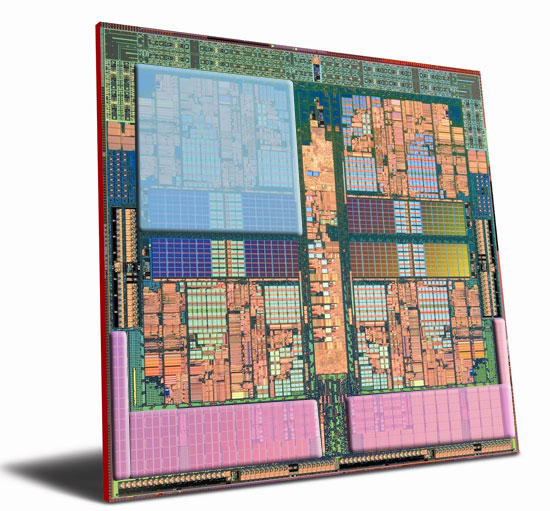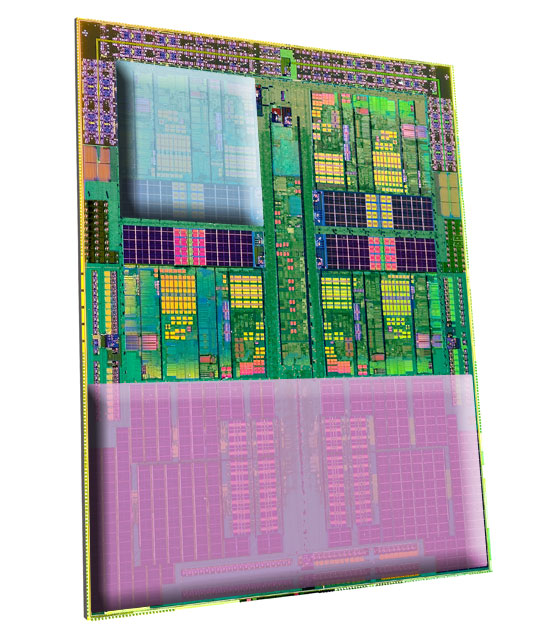AMD Phenom II X4 940 & 920: A True Return to Competition
by Anand Lal Shimpi on January 8, 2009 12:00 AM EST- Posted in
- CPUs
Phenom II's Secret, In Pictures
I can be verbose, I know, I'm sorry - I'm working on it. But on this page, I'll use pictures to illustrate my point. Here's the 65nm Phenom die:

I highlighted one of the four cores in blue. The bottom part of the highlighted core its its 512KB L2 cache. The areas in pink are the 2MB L3 cache that is shared by all four cores. Now look at Phenom II:

Again we've got one of the four cores highlighted blue. The L1 cache size and the core itself look very similar to the original Phenom, but note how the new die is much more rectangular. The pink area represents the Phenom II's 6MB L3 cache.
Just comparing the two die you can see that while the individual cores look similar, the amount of L3 cache has gone up considerably. Remember that Intel found with Nehalem that an 8MB L3 cache was the bare minimum, leaving 2MB per core. The original Phenom had 2MB to share amongst all four cores, which is hardly enough; Phenom II fixes that. With a 6MB L3 cache and 512KB L2 per core, Phenom II looks a lot more like Core i7 from a compute-to-cache ratio:

Nehalem's layout makes a little more sense, with each core butting up against the shared L3 cache, but the point is that in both Phenom II and Core i7, the L3 cache is around 1/3 of the total die. The original Phenom alloted only 1/6th of the die for its L3.










93 Comments
View All Comments
poohbear - Thursday, January 8, 2009 - link
this is fantastic news! and just when i was about to upgrade from my ancient s939 system to a C2D system, seems i might be sticking to AMD after all! thanks for review!PrezWeezy - Thursday, January 8, 2009 - link
For less than $20 more the i7 920 looks like it wins in every single test by a fair margin, doesn't seem like this is really all that competitive, considering the i7 is still in the "high price" phase. I can't believe it wont drop to the $275 mark rather soon which would put the XII 940 back to the same position the original Phenom was, too little too late.Roland00 - Thursday, January 8, 2009 - link
More expensive Motherboard+More expensive Ram makes i7 about 400 dollars more in coststrikeback03 - Friday, January 9, 2009 - link
How you figure? By the chart on page 4, it is less than $200. Even if you go for one of the $300 motherboards, you won't see a $400 difference.When I built my current system, E6600/P965/2GB DDR2 cost me over $600, and that was considered a decent mid-range system. As my primary use of computing power is Photoshop, I would definitely go for i7 even if cheaper motherboards do not become available.
Roland00 - Friday, January 9, 2009 - link
It isn't quite 400 but heremotherboard p45 vs x58 most x58 are 300 vs 100-120 for p45,
Ram, 6 gb of ddr3 is about 200, vs 50 or 60 for 6gb of ddr2.
For a nonstock cpu cooler you are talking 60 to 70 bucks with the i7 for it is a new socket and their is very few products for it. You can get a good cpu cooler for intel quad for 30 to 40 dollars.
Savings about 200+140+30=370
If you get things on sale you might be able to find 6gb ram for 150, cpu for 230, and you may be able to get the motherboard cheaper if you get one of the basic versions but you are still talking about 300 more.
-----
I am not saying i7 isn't worth the extra money, it is still new tech but it does show beneficial gains (on encoding, minimum frame rate on games, and overclocking) but right now the motherboards and ram is expensive.
BSMonitor - Friday, January 9, 2009 - link
You are rounding up on i7 side and rounding down on the core 2 side. It is not $50 for 6GB of DDR2. It is not only $300 for x58. I have seen them for $200. I have seen 6GB DDR3 kits for $140 too.It's like we are talking about bare entry into Core 2 and Phenom II, but enthusiest for i7. Why does one need 6GB to entry into i7? 3GB would be reasonable and ~$70-80.
Phenom II is cute yes, but nothing to jump on.
Roland00 - Friday, January 9, 2009 - link
I am rounding up on the I7 side for like most people I buy things with tax (for my state charges tax on internet transactions.) In addition many people buy their equipment in stores such as fry's, microcenter, comp usa, etc.370 times 8.25% tax rate (my area's sales tax) is...400 dollars and 52 cents
------
And no I am not overpricing the ram or similar equipment. Go to Fry's, Microcenter, or some other store and you will see the prices I listed or much higher.
------
Regardless you seem to be missing the point, the original poster I was responding to was saying i7 was only 25 dollars higher, and I said that was wrong for you have to figure in the platform costs.
PrezWeezy - Friday, January 9, 2009 - link
You were right, I had forgotten about the new socket and DD3. Even so, using the parts Anandtech used, the i7 is about $187 more expensive than the PII (pun totally intended). The C2D with a Q9400 though is only $44 cheaper than the i7. Almost all of that has to do with the motherboards used here, and I'm sure you could find a combo of motherboard/CPU that would bring the price closer but that's besides the point.calyth - Thursday, January 8, 2009 - link
"In theory, the AMD design made sense. If you were running a single threaded application, the core that your thread was active on would run at full speed, while the remaining three cores would run at a much lower speed. AMD included this functionality under the Cool 'n' Quiet umbrella. In practice however, Phenom's Cool 'n' Quiet was quite flawed. Vista has a nasty habit of bouncing threads around from one core to the next, which could result in the following phenomenon (no pun intended): when running a single-threaded application, the thread would run on a single core which would tell Vista that it needed to run at full speed. Vista would then move the thread to the next core, which was running at half-speed; now the thread is running on a core that's half the speed as the original core it started out on."Anand, read that sentence again.
The problem isn't AMD designing a chip with broken CnQ. The problem is that Microsoft, after so many years, still can't write a scheduler. The problem persists on XP too. The thread that handles the mouse would rev up, causing the chip to switch p-state. Switching p-states takes time, and because of exclusive caching on AMD chips, when the scheduler puts the same thread on different cores, it causes the L1 & L2 to be ineffective.
I have trouble in WinXP with CnQ on if I move my mouse, but not surprisingly, the same Phenom chip works like a chap in Linux. Because the scheduler isn't an idiot, and 1GHz is more than enough to handle mouse input.
AMD erred in fixing a software problem in hardware. Independent p-states saved some power if only a single thread needed the speed.
Zak - Thursday, January 8, 2009 - link
Well, I hope AMD won't lose the momentum, because right now there isn't that much to celebrate: they've barely caught up with Intel's 2 years old CPU line:(Z.